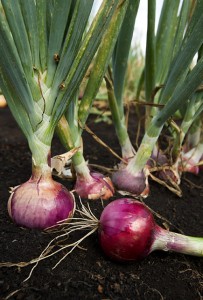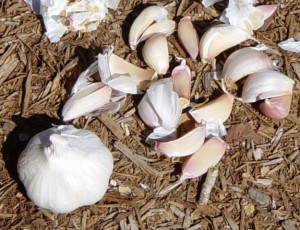Time to Plant Onions and Garlic
go.ncsu.edu/readext?179018
en Español / em Português
El inglés es el idioma de control de esta página. En la medida en que haya algún conflicto entre la traducción al inglés y la traducción, el inglés prevalece.
Al hacer clic en el enlace de traducción se activa un servicio de traducción gratuito para convertir la página al español. Al igual que con cualquier traducción por Internet, la conversión no es sensible al contexto y puede que no traduzca el texto en su significado original. NC State Extension no garantiza la exactitud del texto traducido. Por favor, tenga en cuenta que algunas aplicaciones y/o servicios pueden no funcionar como se espera cuando se traducen.
Português
Inglês é o idioma de controle desta página. Na medida que haja algum conflito entre o texto original em Inglês e a tradução, o Inglês prevalece.
Ao clicar no link de tradução, um serviço gratuito de tradução será ativado para converter a página para o Português. Como em qualquer tradução pela internet, a conversão não é sensivel ao contexto e pode não ocorrer a tradução para o significado orginal. O serviço de Extensão da Carolina do Norte (NC State Extension) não garante a exatidão do texto traduzido. Por favor, observe que algumas funções ou serviços podem não funcionar como esperado após a tradução.
English
English is the controlling language of this page. To the extent there is any conflict between the English text and the translation, English controls.
Clicking on the translation link activates a free translation service to convert the page to Spanish. As with any Internet translation, the conversion is not context-sensitive and may not translate the text to its original meaning. NC State Extension does not guarantee the accuracy of the translated text. Please note that some applications and/or services may not function as expected when translated.
Collapse ▲Interested in cultivating sweet, home-grown onions and flavorful garlic in your own backyard? If so, now is the time to plant. Growing onions from seed and garlic from cloves is easy to do in home gardens. Onions and garlic have few pest problems, and crops started now will be ready for harvest in spring. Ensure your success by preparing your soil well and choosing varieties recommended for the south.
Soil Preparation
Onions and garlic need good soil conditions and full sun to grow well. Good drainage is essential. So is a rich, loamy soil with plenty of organic matter. Raised beds are ideal for growing onions and garlic since they provide good drainage and can easily be amended by tilling 2”-3” of compost into the soil.
Onions and garlic grow best when the soil pH ranges from 6.0 to 6.5. If you have acidic soil, you will need to add lime. To find out your soil pH, and if lime and nutrients need to be added, submit soil samples to the NC Department of Agriculture for free analysis. Soil test boxes, forms and instructions are available from any Cooperative Extension office. Completed samples can be dropped off at any Extension office for free shipping to the NCDA Soil Test Lab in Raleigh. Your results will be posted online, usually within two to three weeks of submitting samples.
Growing Onions
In SE NC, the easiest way to grow onions is from seed planted directly into the garden from mid September through late October. Plant seed 1” apart and ½” deep in well prepared soil. Be sure to keep newly planted seed evenly moist to ensure good germination and growth. As the onions grow, thin out the seedlings so individual plants stand 3” to 4” apart. Onions pulled during thinning can be used as green onions.
The real key to success with onions is to grow varieties suited to our area. Bulb production in onions is heavily influenced by day length. Because of this, onions are separated into long day and short day varieties. Long day varieties are grown in the northern US in the summer, while short day varieties are grown in the southern US through the winter. Short day varieties are sweet but do not store well for extended lengths of time.
Favorite short day varieties for our area include Texas Supersweet, a large sweet yellow onion; Grano varieties, available in yellow and red selections; Granex, often grown in Vidalia, GA; and Candy, a white, day neutral variety that can be grown in fall or summer.
Growing Garlic
Garlic is best planted from cloves purchased from garden centers or mail order companies since garlic purchased from grocery stores may have been treated to prevent sprouting. Individual cloves should be planted 1” deep and around 4” apart in well drained, well prepared soil. Both hard neck and soft neck varieties are available. Soft neck varieties are recommended for southern gardens. These varieties have a slightly milder flavor and are good for braiding.
Though not a true garlic, elephant garlic grows well in the south and is cultivated the same as garlic. Elephant garlic looks similar to garlic, except it produces four to six large cloves that have a very mild garlic flavor. Shallots can also be grown in the fall in the south and are planted from bulbs.
More Tips
Onions and garlic don’t compete well with weeds, so keep these crops well weeded. Both require a steady supply of moisture and nutrients, which is best achieved by mixing compost into the soil and applying a slow release or organic fertilizer at planting time and again in the early spring. High soil sulfur levels make onions hotter, though most sandy soils are naturally low in sulfur. Avoid adding sulfur to the soil if you want sweet onions.
If you’re mainly interested in harvesting green onions (aka scallions) then plant bunching varieties like ‘Evergreen Bunching’ which form plenty of tops but no bulbs. Green onions can be ready for harvest in as little as 30-40 days from seeding. Sow a new batch every few weeks through late October for successive harvest. Green onions can also be grow in spring, with spring crops planted outside in March and April. If you have limited space, consider planting chives, an easy to grow perennial herb related to onions. Chives grow well in containers and their leaves can be harvested from spring through fall. Garlic chives is similar, but has a pronounced garlic flavor.
Learn More
Learn more about growing onions, garlic, and their relatives from this Clemson Extension fact sheet: http://www.clemson.edu/extension/hgic/plants/vegetables/crops/hgic1314.html
Visit your local Cooperative Extension office to learn more about gardening and landscape care. Go to https://www.ces.ncsu.edu/local-county-center/ to find your county Extension center.
- If you live in Pender County, call 910-259-1235
- In New Hanover County, call 910-798-7660
- In Brunswick County, call 910-253-2610
- In Onslow County, call 910-455-5873
- In Duplin County, call 910-296-2143





